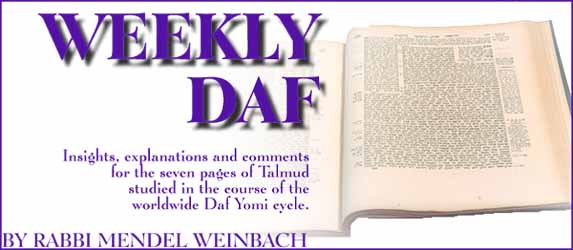When More is Less
Menachos 58-64 -- Issue #125
14-20 Tamuz 5756 / 1-7 July 1996
This publication is also available in the following formats:
When More is Less
When the Sixteenth of Iyar, the day on which the Omer meal offering was made in the Temple, fell on Shabbos, the barley required for producing the flour was cut on that holy day because the Torah ordered that the Shabbos prohibition against reaping be set aside in order to enable the offering. In deference to the Shabbos, ruled Rabbi Yishmoel, only three seah measures of barley were cut to produce the flour instead of the five cut on a weekday in order to have more raw material to produce a more refined flour.What will Rabbi Yishmoel rule in the following case? A man is deathly ill and two figs can save his life. The Shabbos prohibition against picking fruit from a tree is certainly put aside for saving a life. But the only figs available are: 1) two separate figs each on its own stem, requiring two acts of removing fruit from the tree; and b) three figs growing from one stem and requiring only one act of picking from the tree.
Will Rabbi Yishmoel's rule of minimizing the amount of grain to be cut compel us here also opting for picking the two figs required so as not to pick an extra one?
The Talmud's resolution is that you certainly will pick the one stem with the three figs, for in that fashion you minimize the acts of removing fruit. Picking the two separate stems only increases the number of normally prohibited acts, unlike the Omer situation in which less barley harvested results in less acts of creative work.
Sign Language
During the Hasmonean dynasty in the Second Temple Era a civil are raged between two brothers, Hierkonys and Austobalus, over who should rule the nation. The forces of Hierkonys which laid siege to Jerusalem where Aristobalus was entrenched destroyed all the grain fields around the city. When barley was needed for the Omer meal offering on Pesach and wheat for the two loaves offering on Shavuos the Sages issued a call to the general community for help in locating some fields whose produce was still intact.In both cases a mute answered the call and communicated, in sign language, the location of a surviving field. Mordechai, of Purim fame, was still alive and it was he who deciphered their cryptic messages with his great wisdom and directed the sages to the distant sites.
The reason for the destruction of the crops, explains Maharsha, was to prevent those inside the city from performing the Temple service, just as they also prevented them from offering a lamb as the daily sacrifice by substituting a pig for the animal customarily provided. Loyalists therefore concealed the crops from the enemy in two remote fields whose very names indicated the element of concealment. The only ones in the city whom they could trust with this secret were individuals incapable of speech. It was these mutes who eventually revealed the hiding paces knows only to them and enabled the sacred service to continue in the Temple.
General Editor: Rabbi Moshe Newman
Production Design: Lev Seltzer
HTML Design: Michael Treblow
© 1995 Ohr Somayach International - All rights reserved. This publication may be distributed to another person intact without prior permission. We also encourage you to include this material in other publications, such as synagogue newsletters. However, we ask that you contact us beforehand for permission, and then send us a sample issue.
This publication is available via E-Mail
Ohr Somayach Institutions is an international network of Yeshivot and outreach centers, with branches in North America, Europe, South Africa and South America. The Central Campus in Jerusalem provides a full range of educational services for over 685 full-time students.
The Jewish Learning Exchange (JLE) of Ohr Somayach offers summer and winter programs in Israel that attract hundreds of university students from around the world for 3 to 8 weeks of study and touring.
Ohr Somayach's Web site is hosted by DreamHost
 Copyright © 1995 Ohr Somayach International. Send us feedback.
Copyright © 1995 Ohr Somayach International. Send us feedback.Dedication opportunities are available for Weekly Daf. Please contact us for details.







